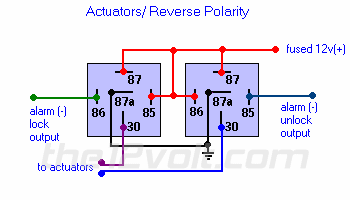fisherangel7 wrote:
Also just because someone asks the time of day doesn't they can't tell time. If you are going to arrogant, please do it on your own time. thanks. |
|
|
I appologize if you think I'm being arrogent, I just don't understand how you're going to program a microcontroller, download the program, power it, and run your solenoid if you can't figure this simple circuit out. I posted a fairly detailed description of how it works, yet it wasn't enough for you to figure out. I appologize that I am unwilling to spend 30 minutes drawing up a diagram that you should be able to figure out from my description. To me, it seems like you have a group project for school or something and this is your "part" of the assignment. I could be wrong, but thats what it seems like.
fisherangel7 wrote:
| Ok.. then since you are so clever, how then do you have a relay providing a reversing polarity to the big xx solenoid and that same relay completely unpowered on either control side or power thru contacts side when pulse is not coming thru. We know it could probably be worked out with mosfets.. but we were hoping some good guru had already perfected. I guess we were looking for someone who does it for a living and is up on the subject and could just zap out a schematic. Obviously its beyond your abilities or Probably you don't know??? |
|
|
OK, I'm not sure how else to explain this so you understand. You already posted:
fisherangel7 wrote:
Best way to Reverse Both + and - on a solenoid? I have solenoid that is latching type single coil SPDT . I need to reverse the polarity with one pulse in either direction to cause it to switch from position A to position B and vice versa/ WHat is best way to do it with 12 relays lowest parts count.. thanks. |
|
|
So, I'm assuming all you need is the ability to provide REVERSE POLARITY pulses to the solenoid in question. You went a step further to add that you want it done off of one output pin (not port like you keep calling it, a port is a group of pins). This can EASILY be done with two SPDT relays in a typical "five wire" configuration. The NC pins of BOTH relays rest at ground and the NO pins are connected to 12vdc. So, normally, the solenoid has a ground on BOTH wires (and therefore no current flows). When you fire ONE relay it removes a ground from the solenod and replaces it with voltage. This creates a REVERSE POLARITY PULSE to pulse the solenoid you mentioned above. When you return your output pin to a high impedence state the relay will shut off, and NO CURRENT will flow through any parts. The solenoid will stay latched because YOU said it was a latching solenoid.
Mosfets will work, but are overkill and are very sensitive. They should only be used when you need a very low on resistance (to minimize heat) or if you need high speeds - you need neither here. I would go with NPN and PNP transistors that are pretty much bullet proof for your application.
Do you have any idea how much current your solenoid is going to require to pull in? The amount of current needed to energize the solenoid will ultimately determine the "best" way to do what you are trying to do.
Kevin Pierson
 Printable version
Printable version

















